Exchanging your coins
There are a lot of different cryptocurrencies around at the moment. Of these, there are a few top-tier coins, such as Bitcoin and Etherium. There are many, many others too.
Some of these other coins aim to be the dominant coin. For instance, Bitcoin Cash has features that some claim make it a more useful coin than Bitcoin, and they suggest that everyone move over to Bitcoin Cash instead of using Bitcoin. (It's a heated argument, and not one I'm making a specific recommendation on!) Other coins are specialised, like Golem, designed to be for people to sell their computing power to others.
Regardless of the exact coins, you may want to convert your coins from one coin to another, or even just convert a little at a time. Doing this requires a way to exchange your coins. Most of the time, you do this by converting from your coin to Bitcoin, and then from Bitcoin to the other coin. Bitcoin is chosen due to its dominance in the crypto-world, and its easier to just have one conversion to bitcoin, than between all possible coin-pairs. That said, some websites do provide other direct coin-exchanges.
One such website is the exchange Binance, which allows you to convert between coins on an open exchange. One thing to note is that Binance is an exchange, where you make an offer of your coin and the price you want to sell or buy at. At that point, someone else needs to come along and fulfil that order. As an exchange, Binance records that "I want to sell 3 Etherium for 0.125 Bitcoin". Other people come through, accept that offer and perform the trade. If you are selling for too much, your trade may not find a buyer!
There are other services, like Shapeshift, that simply convert your coins, but they simply just set the price to whatever is needed to do the conversion (i.e. market price, which we will use in a minute), or those services keep a cache of coins for conversion and determine their own price. This makes it nice and easy to use, but it may not be the best price for you!
In the rest of this lesson, I'll go through the process of using Binance to convert coins from one type (Bitcoin - BTC) into another type (EOS). Every exchange will be slightly different, and ensure you are aware of the consequences of your steps before you take them. Remember, you are dealing with coins of value, and mistakes are often very hard or impossible to undo. Take it slowly and carefully!
Step 1: Register
Sign up on Binance with an account. If you want to exchange large amounts, you will need to formally identify yourself, which you can do from your account settings, found on the top right of the screen. After you have registered, sign into Binance.
Step 2: Deposit funds
To exchange, you'll need some initial coin. I recommend Bitcoin as the initial coin as there are more places to buy bitcoin. That said, Binance accepts many different coins.
Click the Funds option on the top navigation bar, and click Deposits Withdrawals.
The menu bar is shown below.

This next screen shows all the coins that Binance can accept. Choose your deposit coin (i.e. the coin you already have) and click Deposit.
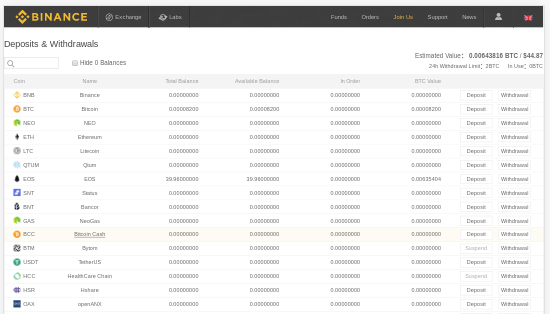
In the screen below, I had some spare Litecoin and used that coin to deposit.

Copy your address and send the coin from your other wallet. I'm going to use Bitcoin, but be aware that it has high transaction fees compared to other coins. Check Binance's list of coins, compare with what you have or can get, and find a coin that suits you.
Double check the hash before sending, and also confirm you are sending the right coin. As an example, Bitcoin Cash addresses look exactly like normal Bitcoin addresses, and no error will be identified, but your money will not turn up! Check with a local expert if you are unsure - there are many coins that share similar address structures.
After your coins have arrived, you'll have a listed balance in Binance.
Step 3: Trade at Market Prices
Click the Exchange button in the top menu, then choose Basic.
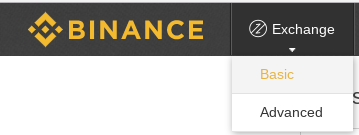
On the right of the screen is a search bar. In this bar, enter the non-bitcoin coin you want to convert to or from.
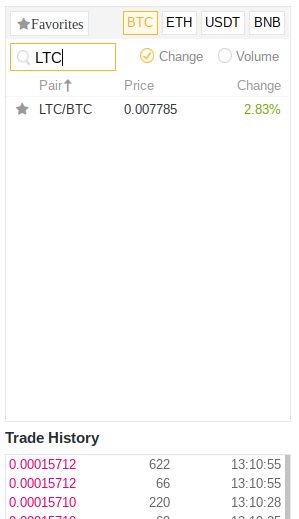
I'll do two trades in this lesson. First, I'll sell my LTC (Litecoin) for some BTC (Bitcoin), and then I'll also trade Bitcoin for EOS. First, I enter LTC, and LTC/BTC comes up. Click that entry, and it shows the trades for this conversion.
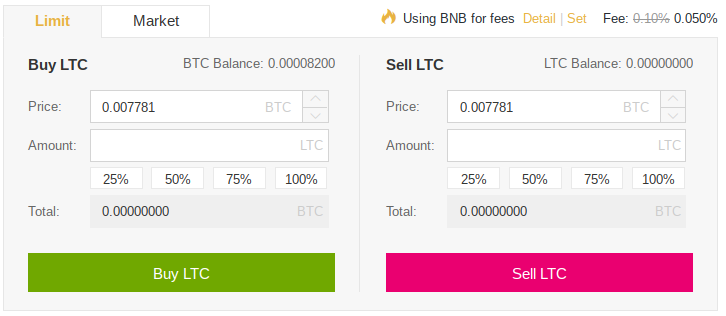
At the bottom of the screen is a tabbed section with the options "Trade" or "Market". If you want to set your price, select Trade. If you want to let the market decide, choose Market.
For this first trade (LTC to BTC), I'll choose Market, which uses the current price of the market. This means the price is set by finding an order that can fulfil your request to buy or sell, and then selecting that price. Sometimes this doesn't happen (i.e. if the price drastically drops just as you put your trade in, or if you are trading a coin with no buyers at the moment).
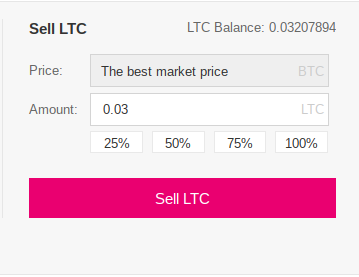
I want to trade all of my LTC for BTC, and therefore select the 100% option. If you have a specific amount to trade, you can enter that manually, or select as a percentage.
After making your order, if it was a Market order, it is usually performed pretty quickly.
You can check by clicking Orders in the top menu, and then Open Orders to seen any incomplete orders.
If your order is not there, click Orders again and then Order History to see your order.
Step 4: Trade at your price
If you want to set your price, you need to use the Trade tab we saw earlier.
Click Exchange and Basic again to go to the basic exchange screen.
Enter the non-bitcoin coin in the search menu (I'm converting my bitcoin to EOS) and select the conversion.
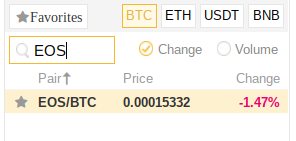
The ticker will show the current price. At the time of writing, the conversion was 1 EOS for 0.00015200 BTC. I'd like to buy if the price dips a little, so I set my price at 0.000145BTC. The order will not process straight away. Instead, it will likely sit in the queue until people sell at higher prices. If the price drops to my offer, someone may choose to sell their EOS for my price.
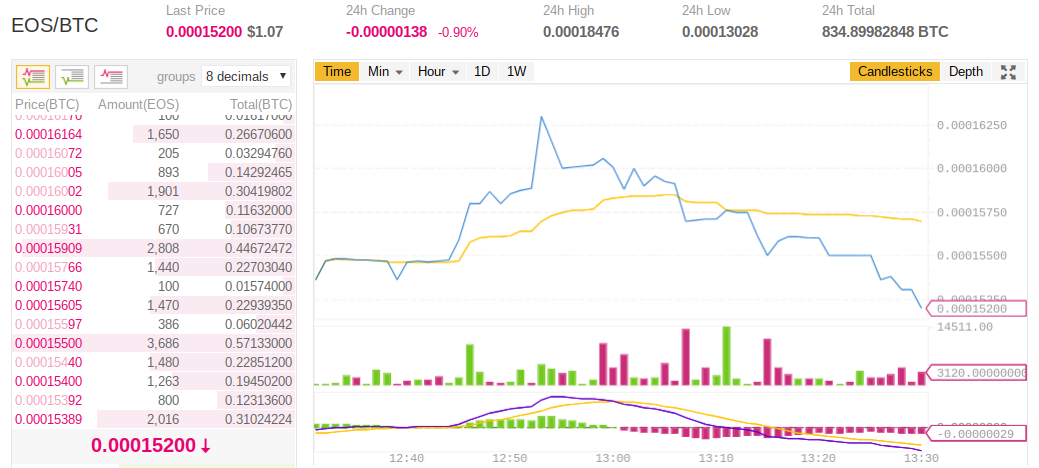
You need to enter the current price you are offering, as well as how many coins you are buying or selling at that price. In my example, I want to buy 10 EOS and am willing to pay 0.000145 BTC per EOS.
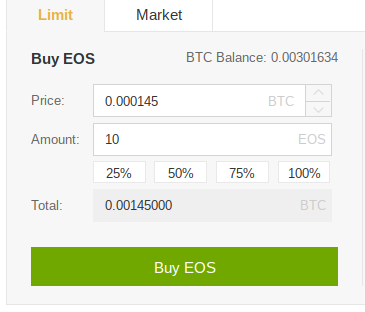
You can see how hard it will be to sell at a given price by checking the depth chart.
On the top right of the plot in the middle of the screen, select Depth.
The depth chart highlights the cumulative orders at different prices.
It has pointed to my price, and it shows all the buy orders that need to be fulfilled that are at higher prices in green and to the right of my order.
That's a lot of orders!
Learning to read depth charts can give you a sense of how easy or hard it will be to sell or buy at a given price.
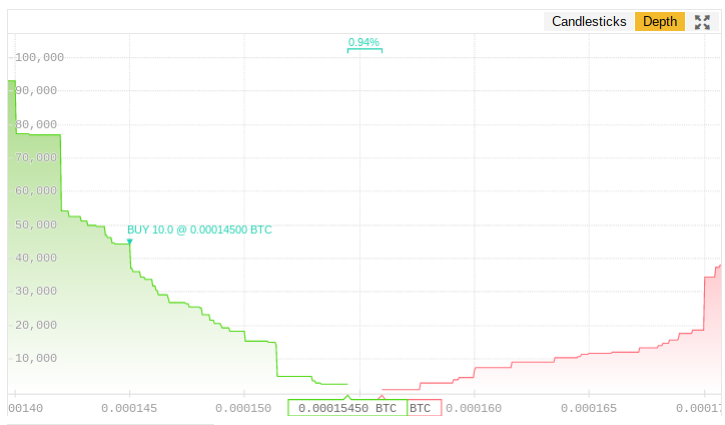
That's it on exchanging coins. If you use our referral links to Binance above, half of your transaction fees to to the site, helping us stay up and with new content coming regularly. On top of that, it doesn't cost you any more than usual to do your transactions!